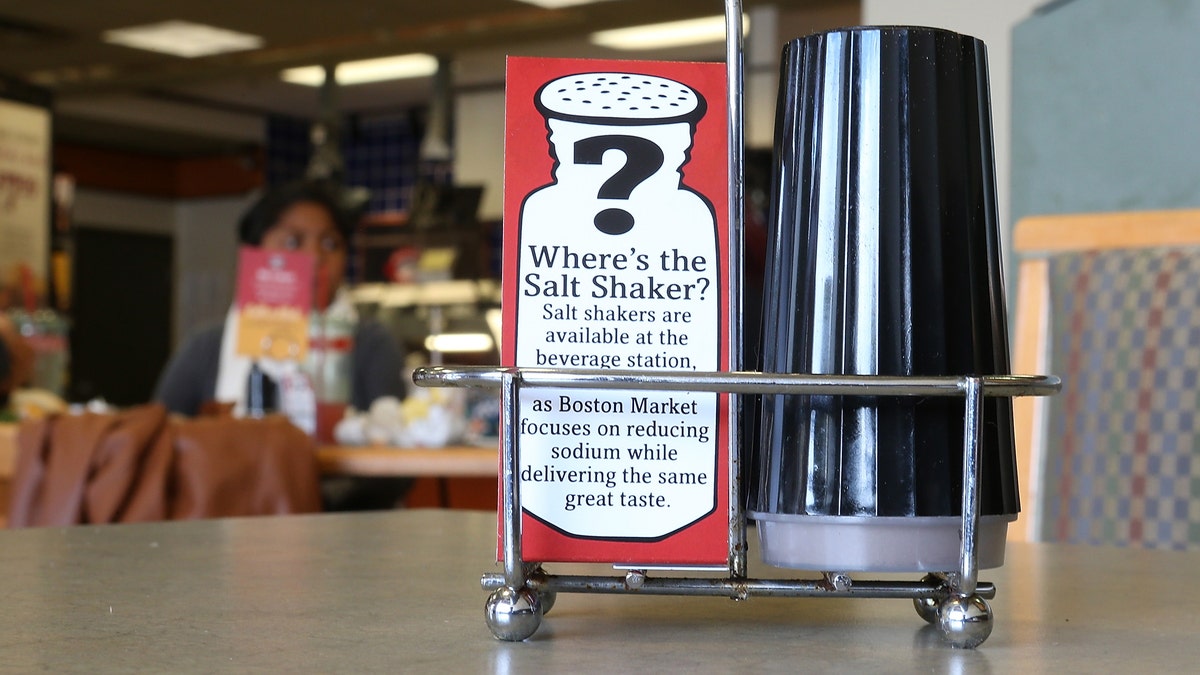
A sign explaining the absence of salt shakers is posted on a table inside a Boston Market restaurant on August 21, 2012 in San Francisco, California. (Photo by Justin Sullivan/Getty Images) (2012 Getty Images)
Have you noticed some of your favorite foods have been lacking in flavor?
That's because the world’s universal seasoning ingredient has quietly been slipping out of dozens of the most familiar foods in brand-name America.
From Butterball turkeys to Goya canned beans, companies are increasing their efforts to reduce the sodium levels in their products.
A Kraft American cheese single has 18 percent less salt than it did three years ago. The salt in a dollop of Ragu Old World Style pasta sauce is down by 20 percent. A handful of honey Teddy Grahams has 33 percent less salt. A squirt of Heinz ketchup is 15 percent less salty.
Their manufacturers are among 21 companies that have met targets so far in a voluntary, New York City-led effort to get food manufacturers and restaurateurs to lighten up on salt to improve Americans' heart health, Mayor Michael Bloomberg announced Monday.
While it remains unclear whether consumers have noticed the changes, campaigns aim to get more salt out of the national diet in the coming years — a challenge for an ingredient that plays a role in the taste, preservation and even texture of food.
Salt reduction has become a recent focus of public health campaigns in the city and elsewhere. Salt, or sodium chloride, is the main source of sodium for most people.
Sodium increases the risk of high blood pressure, a major cause of heart disease and stroke. Dietary guidelines recommend no more than 2,300 milligrams of sodium a day, equal to about a teaspoon of salt; the American Heart Association suggests 1,500 milligrams or less. But average sodium consumption in the U.S. is around 3,300 milligrams, the federal Centers for Disease Control and Prevention have found.
Officials said the first step was a meaningful one.
"The products they're making healthier are some of America's most beloved and iconic foods," noted Bloomberg, a fan of Subway's meaty Italian BMT sandwiches, which are now 27 percent less salty.
"A decrease is good — not putting anything in there is even better. People should add their own salt," Manhattan grocery store shopper Lynne Davis said.
Health officials say Americans get the vast majority of their salt from processed and prepared foods, and not necessarily the foods they'd imagine: Bread and rolls are the No. 1 source.
"The problem is not the salt on the table. The problem is the salt on the label," city Health Commissioner Dr. Thomas Farley said.
The amount of salt in any given food item can vary widely. A slice of white bread can have 80 to 230 milligrams of sodium, for example. A cup of canned chicken noodle soup has 100 to 940 milligrams. A 1-ounce bag of potato chips ranges from 50 to 200 milligrams.
In one of a series of healthy-eating initiatives on Bloomberg's 11-year watch, the city announced voluntary salt guidelines in 2010 for various restaurant and store-bought foods. Besides trimming salt levels in the foods by 25 percent by 2014, the campaign aimed to reduce consumers' overall sodium intake by 20 percent in the same timeframe. Interim targets for the foods were set for 2012.
Kraft Foods Inc. research Vice President Russ Moroz said maintaining the taste is "really the challenge in continuing to reduce sodium.”
"If you don't make foods that taste good, people don't buy them, and, in the end, we haven't really done anything to impact the diet in the country," Moroz said.
Based on reporting by the Associated Press.
Follow us on twitter.com/foxnewslatino
Like us at facebook.com/foxnewslatino
